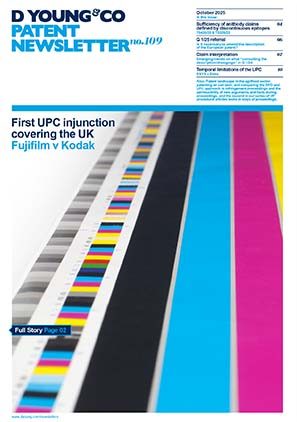Added matter: disagreement between Patents Court & EPO
Added Matter: disagreement between Patents Court and EPO, plus an injunction covering more than the claimed medical use indication. Novartis Pharmaceuticals UK Limited v Dr Reddy's Laboratories (UK) Limited [2019] EWHC 92 (Pat).
Because of a different stance on added matter, Novartis were able to obtain a preliminary injunction from the Patents Court of England and Wales preventing Dr Reddy’s Laboratories from launching a generic version of the drug everolimus (which is sold under the name Afinitor). The injunction prevents sales of the generic drug for the claimed medical use and for other medical uses.
Background
90% of the UK market for everolimus is for the treatment of hormone receptor positive breast cancer.
Novartis had an SPC for everolimus per se which was set to expire on 17 January 2019. In addition, Novartis have a patent with a second medical use claim to this drug - EP(UK)2269603 (which was filed on 18 February 2002). The only independent claim of this patent reads:
40-O-(2-hydroxyethyl)-rapamycin in combination with exemestane for use in the treatment of hormone receptor positive tumor, wherein the hormone receptor positive tumor is a breast tumor.
The compound 40-O-(2-hydroxyethyl)-rapamycin is known as everolimus.
During EPO opposition proceedings against EP2269603 held in June 2018, the Opposition Division decided that the claim was invalid because it contained added matter. The EPO Opposition Division stated in the written decision that “there is no pointer to the specific combination therapy comprising [everolimus] together with exemestane for the specific treatment of hormone receptor positive [breast] tumor”. In addition, the Opposition Division considered that “the skilled person would not have seriously contemplated this combined selection of features as emerging clearly and unambiguously from the content of the application as filed”. Hence, the EPO concluded that the claim comprises added matter.
Unsurprisingly, Novarits is appealing this decision and, in view of pending litigation in various European jurisdictions, requested accelerated handling of the appeal proceedings. At the time of writing, no date has been set for the appeal hearing.
A marketing authorisation for everolimus was obtained by Dr Reddy’s in July 2018. This marketing authorisation includes, amongst other uses, the use of everolimus as per the above second medical use claim. Dr Reddy’s intended to launch generic everolimus after the SPC expired on 17 January 2019.
Novartis sought and was awarded a preliminary injunction to prevent this launch. In the decision from the Patents Court, interesting comments in relation to added matter objections were made by the Patents Court which diverge from the decision made by the EPO Opposition Division. The preliminary injunction prevents not just sales of the generic drug relating to the claimed medical use but also prevents sales for other indications.
The Patents Court’s position on added matter
Dr Reddy’s position was that the launch of generic everolimus would not infringe the patent EP(UK)2269603 because the patent is invalid. In its submissions, Dr Reddy’s referred to a section of the EPO’s case law book concerning “selection from two lists and deletion of elements from two lists” and asserted that selecting items from two lists means that a claim may comprise added matter.
Novartis submitted an expert report from a Professor of Breast Cancer medicine in which it was his opinion that the claim was disclosed and there is no added matter.
The judge formed a “provisional but clear view that there was no added matter and that therefore the patent was valid”.
It was noted in the decision that there is no UK case which puts the principle forward as described in the EPO’s case law book. The judge went on to state that “The two list cases may well be examples of cases in which there is added matter” but he did not accept that “as a general statement it is true that a teaching which consists of a combination of two individualised lists…means that the combination is now to be treated as an un-individualised generic disclosure.”.
In summary, the Patents Court disagreed with the decision of the EPO Opposition Division. Notably, it was concluded that “[the EPO Opposition Division’s] decision appears to take an unduly technical approach which has lost sight of the disclosure of the document as a whole and also lost sight of the prominence of [everolimus] in it”.
Scope of the Preliminary injunction
Consideration was given to Dr Reddy’s selling everolimus for non-breast cancer indications. However, given that breast cancer represents 90% of the UK market for everolimus, it was held that it was not appropriate in this case. It was acknowledged that this would restrain Dr Reddy from supplying the product for lawful uses – namely indications outside the claim.
In granting the preliminary injunction, cross-undertakings were made that if the patent is found to be invalid then Dr Reddy’s would be compensated. The judge also provided leave for the Department of Health/NHS to apply to be joined in the cross-undertaking. Considering the cost of everolimus to the Department of Health/NHS, it is likely that they will make the request.
Take home messages
- There is no divergence from EPO case law but a different interpretation of the facts.
- It will be interesting to see if, and how, the comments in this decision by the Patents Court are used in the EPO appeal.
- Moreover, it will be fascinating to see if the EPO Board of Appeal agrees with the Patents Court that the EPO Opposition Division lost sight of the document as a whole.
- Finally, a high market share for a claimed second medical use indication could enable a preliminary injunction to restrain not only product sales for the claimed medical indication but also for indications falling outside the scope of the medical use claim.
This is certainly a case to watch!


